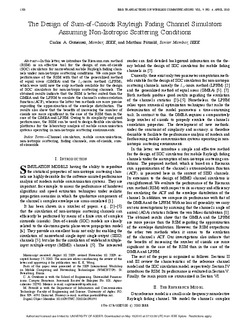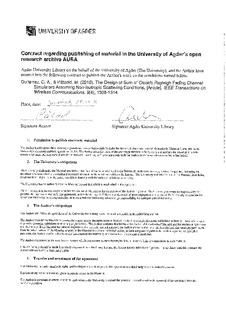| dc.contributor.author | Gutiérrez, Carlos A. | |
| dc.contributor.author | Pätzold, Matthias | |
| dc.date.accessioned | 2010-11-22T16:07:20Z | |
| dc.date.available | 2010-11-22T16:07:20Z | |
| dc.date.issued | 2010 | |
| dc.identifier.citation | Gutierrez, C. A., & Pätzold, M. (2010). The Design of Sum-of-Cisoids Rayleigh Fading Channel Simulators Assuming Non-Isotropic Scattering Conditions. IEEE Transactions on Wireless Communications, 9(4), 1308-1314. doi: 10.1109/twc.2010.04.091198 | en_US |
| dc.identifier.issn | 1536-1276 | |
| dc.identifier.uri | http://hdl.handle.net/11250/137781 | |
| dc.description | Published version of an article from the journal: IEEE Transactions on Wireless Communications. .(c) 2010 IEEE. Personal use of this material is permitted. Permission from IEEE must be obtained for all other users, including reprinting/ republishing this material for advertising or promotional purposes, creating new collective works for resale or redistribution to servers or lists, or reuse of any copyrighted components of this work in other works. Article also available from the publisher: http://dx.doi.org/10.1109/twc.2010.04.091198 | en_US |
| dc.description.abstract | n this letter, we introduce the Riemann sum method (RSM) as an effective tool for the design of sum-of-cisoids (SOC) simulators for narrowband mobile Rayleigh fading channels under non-isotropic scattering conditions. We compare the performance of the RSM with that of the generalized method of equal areas (GMEA) and the L-p-norm method (LPNM), which were until now the only methods available for the design of SOC simulators for non-isotropic scattering channels. The obtained results indicate that the RSM is better suited than the GMEA and the LPNM to emulate the channel's autocorrelation function (ACF), whereas the latter two methods are more precise regarding the approximation of the envelope distribution. The results also show that the benefits of increasing the number of cisoids are more significant in the case of the RSM than in the case of the GMEA and LPNM. Owing to its simplicity and good performance, the RSM can be used to design flexible simulation platforms for the laboratory analysis of mobile communication systems operating in non-isotropic scattering environments. | en_US |
| dc.language.iso | eng | en_US |
| dc.publisher | IEEE | en_US |
| dc.title | The Design of Sum-of-Cisoids Rayleigh Fading Channel Simulators Assuming Non-Isotropic Scattering Conditions | en_US |
| dc.type | Journal article | en_US |
| dc.type | Peer reviewed | en_US |
| dc.subject.nsi | VDP::Mathematics and natural science: 400::Information and communication science: 420::Communication and distributed systems: 423 | en_US |
| dc.subject.nsi | VDP::Technology: 500::Information and communication technology: 550::Telecommunication: 552 | en_US |
| dc.source.pagenumber | 1308-1314 | en_US |

